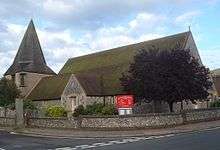Nugent Cachemaille-Day
| Nugent Francis Cachemaille-Day | |
|---|---|
| Born | 1896 |
| Died | 1976 |
| Nationality | British |
| Occupation | Architect |
| Practice |
Welch, Cachemaille-Day, and Lander (1929–35) Independent (1935–) |
Nugent Francis Cachemaille-Day (1896–1976),[1] often referred to as NF Cachemaille-Day, was an English architect who designed some of the most "revolutionary"[2] 20th-century churches in the country. His Church of St Nicholas, Burnage has been called "a milestone in the history of church architecture in England."[3]
After training at the Architectural Association, Cachemaille-Day set up practice with Felix Lander and Herbert Welch as "Welch, Cachemaille-Day, and Lander" in 1929.[1] Their work included the Haymills Estate in Hanger Hill. In 1935 Cachemaille-Day began an independent practice. Shortly afterwards he designed the Church of St Michael and All Angels, Northenden (1936–37), which well illustrates his absorption of "Continental experiments."[4] Pevsner described it as "a sensational church for its country and its day."[5]
From the 1930s he became known for his churches, some of which are the most innovative ecclesiastical buildings of their time. He was one of the leading English architects to embrace the Liturgical Movement. Between 1931 and 1963 he designed at least 61 churches, many of which are now listed buildings.
His churches include St Alban's Church, Southampton and the Church of St Nicholas, Burnage. The interior of St Barnabas, in Stroud Road, Gloucester, built at the foot of the Cotswolds in an estate south of the city, distills Gothic architecture into pure, simple gestures of interchanging arches within a huge hall church: the energy and dance of the Gothic is at the heart of this design, setting up a majestic yet lively space, its scale suggesting the ambition of a cathedral builder.
St Edmund, Chingford, built in 1938, is Grade II listed.[6]
Notes
- 1 2 "Camelsdale - St Paul". Sussex Parish Churches. 2008. Archived from the original on 5 March 2012.
- ↑ Hartwell, Hyde & Pevsner 2004, p. 87.
- ↑ Hartwell, Hyde & Pevsner 2004, p. 410.
- ↑ Hartwell 2001, p. 339.
- ↑ Hartwell, Hyde & Pevsner 2004, p. 493.
- ↑ Historic England, "Church of St Edmund (Grade II) (1191122)", National Heritage List for England, retrieved 7 September 2014
- ↑ Historic England. "Church of St John the Divine (Grade II) (1393431)". National Heritage List for England. Retrieved 4 August 2016.
Sources
- Hartwell, Clare (2001). Manchester. Pevsner Architectural Guides. London: Penguin Books. ISBN 0-14-071131-7.
- Hartwell, Clare; Hyde, Matthew; Pevsner, Nikolaus (2004). Lancashire: Manchester and the South East. The Buildings of England. New Haven, London: Yale University Press. ISBN 0-300-10583-5.
